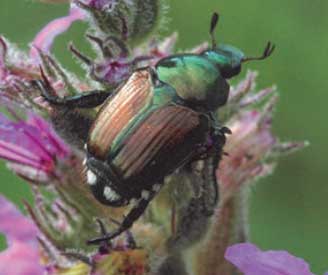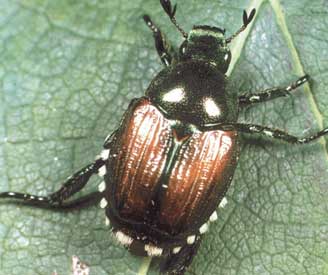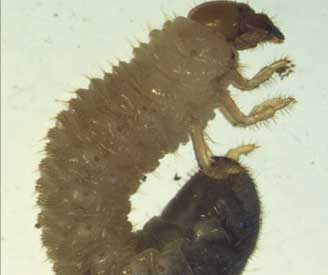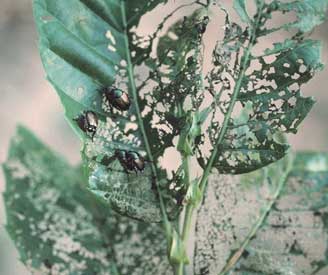Japanese Beetle
Popillia japonica
Description
Scarab beetle, similar to a June beetle/June bug. One year lifecycle. Metallic green head and abdomen with brown elytra. Five white tufts similar to hair along the edges of elytra. About 12 mm long. White grub larvae have gray abdomens and brown heads. Learn more here.
Hosts
Larvae are found feeding on turf roots. Among the plants most commonly damaged are rose, grape, crabapple, and beans, but will feed on over 300 plant species.
Pathway of Introduction and Spread
First found in New Jersey in 1916; originally from Japan. Spreads through the movement of infested nursery stock, as hitchhikers on vehicles or in cargo.
Symptoms
Skeletonized leaves and defoliation of host plants. Root damage to lawns caused by the larvae. Learn about control options Here.
Location in Nebraska
Positive traps found in several Nebraska counties across the state (2011). It is distributed throughout the U.S. (except the Southeast).
Management
USDA APHIS-PPQ conducts the Japanese Beetle (JB) Harmonization Program at the Eppley Airport. Trapping the Japanese Beetles takes place in late July, when it was determined that the JB population was a threat to the Western States, the airlines were put under compliance agreements until the adult JB stage ended annually. Nebraska is cooperating with the Otis Laboratory, USDA APHIS PPQ S&T CPHST, to establish an effective biological control agent. In November 2021, a JB biocontrol was dispersed in the Eppley Airport area. The biocontrol agent, Ovavesicula popilliae, is a host-specific microsporidian pathogen that has been shown to significantly increase JB winter mortality and to reduce female fecundity by 50 to 60%. Nebraska has released this biocontrol agent at the Eppley Airfield since 2016 and infected JB have been found in the area.
Learn more on the USDA Animal and Plant Health Inspection Service website.
David Cappaert, Michigan State University, Bugwood.org
Clemson University – USDA Cooperative Extension, Bugwood.org
Jerry A. Payne, USDA Agricultural Research Service, Bugwood.org
Mike Reding and Betsy Anderson, USDA Agricultural Research Service, Bugwood.org



